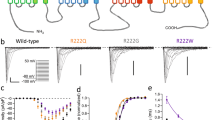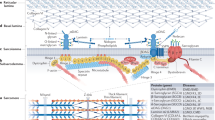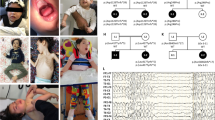Abstract
Mutations in the skeletal muscle sodium channel gene (SCN4A) have been described in paramyotonia congenita (PMC) and hyperkalaemic periodic paralysis (HPP). We have found two mutations in SCN4A which affect regions of the sodium channel not previously associated with a disease phenotype. Furthermore, affected family members display an unusual mixture of clinical features reminiscent of PMC, HPP and of a third disorder, myotonia congenita (MC). The highly variable individual expression of these symptoms, including in some cases apparent non–penetrance, implies the existence of modifying factors. Mutations in SCN4A can produce a broad range of phenotypes in muscle diseases characterized by episodic abnormalities of membrane excitability.
This is a preview of subscription content, access via your institution
Access options
Subscribe to this journal
Receive 12 print issues and online access
$209.00 per year
only $17.42 per issue
Buy this article
- Purchase on SpringerLink
- Instant access to full article PDF
Prices may be subject to local taxes which are calculated during checkout
Similar content being viewed by others
References
Fontaine, B. et al. Hyperkalemic periodic paralysis and the adult muscle sodium channel alpha-subunit gene. Science 250, 1000–1002 (1990).
Koch, M. et al. Confirmation of linkage of hyperkaelemic periodic paralysis to chromosome 17. J. med. Genet. 28, 583–586 (1991).
Koch, M. et al. Linkage data suggesting allelic heterogeneity for paramyotonia congenita and hyperkalemic periodic paralysis on chromosome 17. Hum. Genet. 88, 71–74 (1991).
Ptacek, L.J., Tyler, F., Trimmer, J.S., Agnew, W.S. & Leppert, M. Analysis in a large hyperkalemic periodic paralysis pedigree supports tight linkage to a sodium channel locus. Am. J. hum. Genet. 49, 378–382 (1991).
Ptacek, L.J. et al. Paramyotonia congenita and hyperkalemic periodic paralysis map to the same sodium-channel gene locus. Am. J. hum. Genet. 49, 851–854 (1991).
Ebers, G.C. et al. Paramyotonia congenita and hyperkalemic periodic paralysis are linked to the adult muscle sodium channel gene. Ann. Neurol. 30, 810–816 (1991).
McClatchey, A.I. et al. Dinucleotide repeat polymorphisms at the SCN4A locus suggest allelic heterogeneity of hyperkalemic periodic paralysis and paramyotonia congenita. Am. J. hum. Genet. 50, 896–901 (1992).
Ptacek, L.J., Tawil, R., Griggs, R.C., Storvick, D. & Leppert, M.F. Linkage of atypical myotonia congenita to a sodium channel locus. Neurol. 42, 431–433 (1992).
McClatchey, A.I. et al. Temperature-sensitive mutations in the III-IV cytoplasmic loop region of the skeletal muscle sodium channel gene in paramyotonia congenita. Cell, 68, 769–774 (1992).
Ptacek, L.J. et al. Mutations in an S4 segment of the adult skeletal muscle sodium channel cause paramyotonia congenita. Neuron 8, 891–897 (1992).
Rojas, C.V. et al. A met-to-val mutation in a skeletal muscle Na channel alpha-subunit in hyperkalemic periodic paralysis. Nature 354, 387–389 (1991).
Ptacek, L.J. et al. Identification of a mutation in the gene causing hyperkalemic periodic paralysis. Cell 67, 1021–1027 (1991).
De Silva, S.M., Kuncl, R.W., Griffin, J.W., Cornblath, D.R. & Chavoustie, S. Paramyotonia congenita or hyperkalemic periodic paralysis? Clinical and electrophysiological features of each entity in one family. Muscle Nerve 13, 21–26 (1990).
Haimovich, B., Schotland, D.L., Fieles, W.E. & Barchi, R.L. Localization of sodium channel subtypes in adult rat skeletal muscle using channel-specific monoclonal antibodies. J. Neurosci. 7, 2957–2966 (1987).
Schotland, D.L., Fieles, W.E. & Barchi, R.L. Expression of sodium channel subtypes during development in rat skeletal muscle. Muscle Nerve 14, 142–151 (1991).
Gillard, E.F. et al. A substitution of cysteine for arginine 614 in the ryanodine receptor is potentially causative of human malignant hyperthermia. Genomics 11, 751–755 (1991).
Levitt, R.C. et al. Evidence for genetic heterogeneity of malignant hyperthermia susceptibility. Genomics 11, 543–547 (1991).
Deufel, T. et al. Evidence for genetic heterogeneity of malignant hyperthermia susceptibility. Am J. hum. Genet. 50, 1151–1161 (1992).
Seizinger, B.R., Martuza, R.L. & Gusella, J.F. Loss of genes on chromosome 22 in tumorigenesis of human acoustic neuroma. Nature 322, 664–667 (1986).
George, A.L., Komisarof, J., Kallen, R.G. & Barchi, R.L. Primary structure of the adult human skeletal muscle voltage-dependent sodium channel. Ann. Neurol. 31, 131–137 (1992).
Author information
Authors and Affiliations
Rights and permissions
About this article
Cite this article
McClatchey, A., McKenna-Yasek, D., Cros, D. et al. Novel mutations in families with unusual and variable disorders of the skeletal muscle sodium channel. Nat Genet 2, 148–152 (1992). https://doi.org/10.1038/ng1092-148
Received:
Accepted:
Issue Date:
DOI: https://doi.org/10.1038/ng1092-148
This article is cited by
-
Genetic spectrum and founder effect of non-dystrophic myotonia: a Japanese case series study
Journal of Neurology (2022)
-
Substitutions of the S4DIV R2 residue (R1451) in NaV1.4 lead to complex forms of paramyotonia congenita and periodic paralyses
Scientific Reports (2018)
-
Hypokalaemic periodic paralysis and myotonia in a patient with homozygous mutation p.R1451L in NaV1.4
Scientific Reports (2018)
-
An algorithm for candidate sequencing in non-dystrophic skeletal muscle channelopathies
Journal of Neurology (2013)
-
Mutations of Sodium Channel α-Subunit Genes in Chinese Patients with Normokalemic Periodic Paralysis
Cellular and Molecular Neurobiology (2008)




